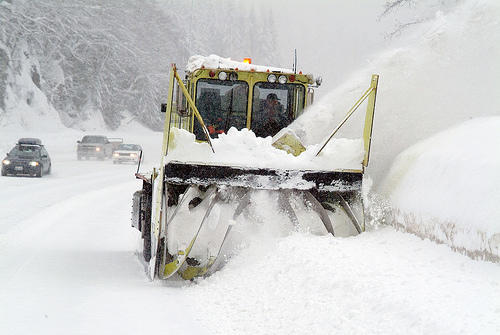Preparing Your Car For Winter – It’s That Time Again
Winter can be harsh on your car. Issues that are often ignored during more temperate months can become critical during the extreme conditions of winter. Preparing your car for plummeting temperatures and inclement weather will ensure that your car keeps running and that you avoid having to pay for costly repairs.

Don't get caught in a snowstorm unprepared - follow these tips
Here’s what you need to do:
1. Check those fluids. Clean oil and a new oil filter can help your car start more easily in low temperatures, so an oil change is a good starting point. Mechanics or oil change specialists will usually also check your power steering, brake and transmission fluids, which are all critical parts of safe winter driving. Use a windshield washer fluid that is formulated for winter to avoid freezing. Antifreeze does not need to be changed every year, particularly when “long-life” antifreeze is used, but it is a good idea to check the antifreeze level before winter begins. A mechanic can test the freezing point of your coolant, or you can do it yourself with an antifreeze hydrometer. A leak test of your cooling system may also be a good idea. Leak tests are not always a routine part of a mechanic’s winterizing process, so make it a point to ask your mechanic specifically about performing one.
2. Is your battery OK? Checking your car’s battery is another important part of winterizing. When a car fails to start in winter, it is usually the result of a weak or dead battery. The average life of a car battery is around four years, but batteries that are between two and three years old should be checked. The reason? Batteries lose capacity with time and low temperatures, so even if your battery works great on a hot summer day, you might find that your battery simply doesn’t have the “juice” to get your car started when it’s freezing outside.
You also want to check your battery out because you may find a lot of corrosion on the terminals. It might not seem like a big deal, but battery corrosion inhibits charging and makes starting more difficult. It’s a good idea to clean off your battery terminals (you can use a post cleaning tool) and then cover them with a small amount of petroleum jelly to prevent future corrosion.
3. Belts and hoses. The rubber and plastic in your car’s hoses and belts can begin to dry up and crack during the summer months. Older parts that begin drying and cracking can quickly worsen and break entirely in harsh winter temperatures. Check your radiator hoses, heater hoses, and serperntine belt for signs of rotting, softness or cracks (or ask your mechanic to do so) and then think about changing any parts that show this kind of wear. However, keep in mind that a little cracking is normal…if your belts and hoses are still fairly new (less than 5 years) you might not bother with replacement.
4. Tires, tires, tires. Guess what the most important piece of equipment is on your car on a slippery day? Your tires.
If your tires are showing extensive wear or are beginning to crack or rot, change them before winter begins. Winter months often bring heavy precipitation. Tires that are worn typically do not have good traction on slippery roads. Winter tires can be a lifesaver in snowy or icy climates, since they improve traction on snow and ice. Some vendors can store your regular tires for you during winter, so if your normal tires are still in good condition it may be worth considering. Remember to check your tire pressure regularly in winter, since good traction is dependent on appropriate tire pressure as well as tread.
Author Nicole Rodgers has been blogging in the automotive, business, and insurance industries for three years. Last year when Nicole purchased her car she made sure to check online for cheap insurance quotes. This way she knows she saved money and found the best deal on insurance possible. During her free time she likes to help her family’s nieces and nephews practice driving. She also gives them help with studying for the written DMV tests.








